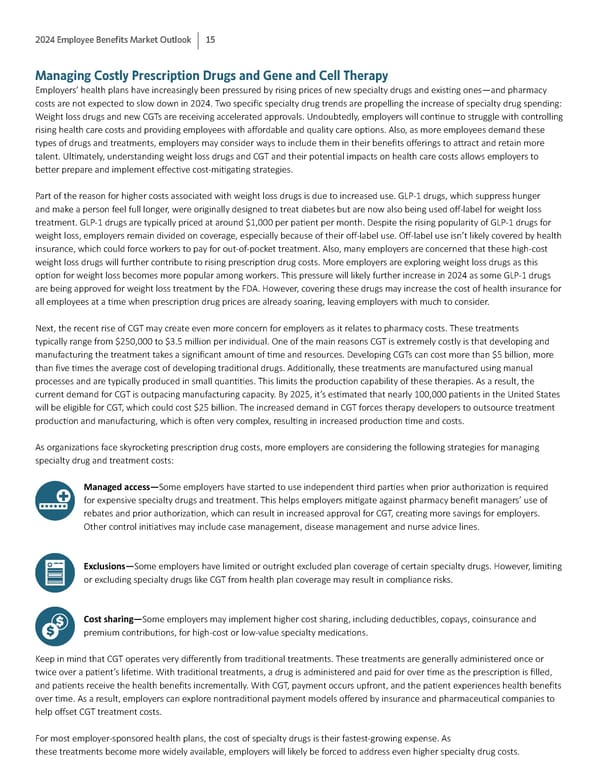2024 Employee Benefits Market Outlook 15 Managing Costly Prescription Drugs and Gene and Cell Therapy Employers’ health plans have increasingly been pressured by rising prices of new specialty drugs and exis琀椀ng ones—and pharmacy costs are not expected to slow down in 2024. Two speci昀椀c specialty drug trends are propelling the increase of specialty drug spending: Weight loss drugs and new CGTs are receiving accelerated approvals. Undoubtedly, employers will con琀椀nue to struggle with controlling rising health care costs and providing employees with a昀昀ordable and quality care op琀椀ons. Also, as more employees demand these types of drugs and treatments, employers may consider ways to include them in their bene昀椀ts o昀昀erings to a琀琀ract and retain more talent. Ul琀椀mately, understanding weight loss drugs and CGT and their poten琀椀al impacts on health care costs allows employers to be琀琀er prepare and implement e昀昀ec琀椀ve cost-mi琀椀ga琀椀ng strategies. Part of the reason for higher costs associated with weight loss drugs is due to increased use. GLP-1 drugs, which suppress hunger and make a person feel full longer, were originally designed to treat diabetes but are now also being used o昀昀-label for weight loss treatment. GLP-1 drugs are typically priced at around $1,000 per pa琀椀ent per month. Despite the rising popularity of GLP-1 drugs for weight loss, employers remain divided on coverage, especially because of their o昀昀-label use. O昀昀-label use isn’t likely covered by health insurance, which could force workers to pay for out-of-pocket treatment. Also, many employers are concerned that these high-cost weight loss drugs will further contribute to rising prescrip琀椀on drug costs. More employers are exploring weight loss drugs as this op琀椀on for weight loss becomes more popular among workers. This pressure will likely further increase in 2024 as some GLP-1 drugs are being approved for weight loss treatment by the FDA. However, covering these drugs may increase the cost of health insurance for all employees at a 琀椀me when prescrip琀椀on drug prices are already soaring, leaving employers with much to consider. Next, the recent rise of CGT may create even more concern for employers as it relates to pharmacy costs. These treatments typically range from $250,000 to $3.5 million per individual. One of the main reasons CGT is extremely costly is that developing and manufacturing the treatment takes a signi昀椀cant amount of 琀椀me and resources. Developing CGTs can cost more than $5 billion, more than 昀椀ve 琀椀mes the average cost of developing tradi琀椀onal drugs. Addi琀椀onally, these treatments are manufactured using manual processes and are typically produced in small quan琀椀琀椀es. This limits the produc琀椀on capability of these therapies. As a result, the current demand for CGT is outpacing manufacturing capacity. By 2025, it’s es琀椀mated that nearly 100,000 pa琀椀ents in the United States will be eligible for CGT, which could cost $25 billion. The increased demand in CGT forces therapy developers to outsource treatment produc琀椀on and manufacturing, which is o昀琀en very complex, resul琀椀ng in increased produc琀椀on 琀椀me and costs. As organiza琀椀ons face skyrocke琀椀ng prescrip琀椀on drug costs, more employers are considering the following strategies for managing specialty drug and treatment costs: Managed access—Some employers have started to use independent third par琀椀es when prior authoriza琀椀on is required for expensive specialty drugs and treatment. This helps employers mi琀椀gate against pharmacy bene昀椀t managers’ use of rebates and prior authoriza琀椀on, which can result in increased approval for CGT, crea琀椀ng more savings for employers. Other control ini琀椀a琀椀ves may include case management, disease management and nurse advice lines. Exclusions—Some employers have limited or outright excluded plan coverage of certain specialty drugs. However, limi琀椀ng or excluding specialty drugs like CGT from health plan coverage may result in compliance risks. Cost sharing—Some employers may implement higher cost sharing, including deduc琀椀bles, copays, coinsurance and premium contribu琀椀ons, for high-cost or low-value specialty medica琀椀ons. Keep in mind that CGT operates very di昀昀erently from tradi琀椀onal treatments. These treatments are generally administered once or twice over a pa琀椀ent’s life琀椀me. With tradi琀椀onal treatments, a drug is administered and paid for over 琀椀me as the prescrip琀椀on is 昀椀lled, and pa琀椀ents receive the health bene昀椀ts incrementally. With CGT, payment occurs upfront, and the pa琀椀ent experiences health bene昀椀ts over 琀椀me. As a result, employers can explore nontradi琀椀onal payment models o昀昀ered by insurance and pharmaceu琀椀cal companies to help o昀昀set CGT treatment costs. For most employer-sponsored health plans, the cost of specialty drugs is their fastest-growing expense. As these treatments become more widely available, employers will likely be forced to address even higher specialty drug costs.
 2024 Employee Benefits Market Outlook Page 14 Page 16
2024 Employee Benefits Market Outlook Page 14 Page 16